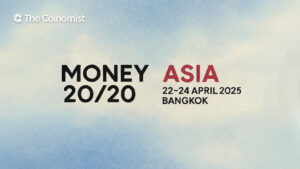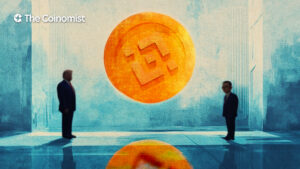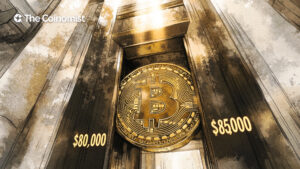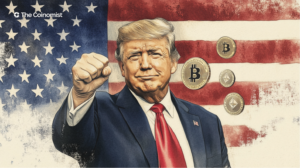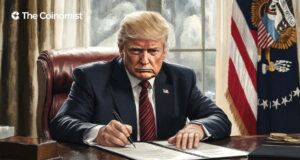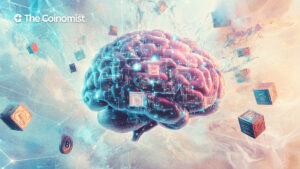Sam Altman, ChatGPT, and the AI Spark That Lit Up Crypto
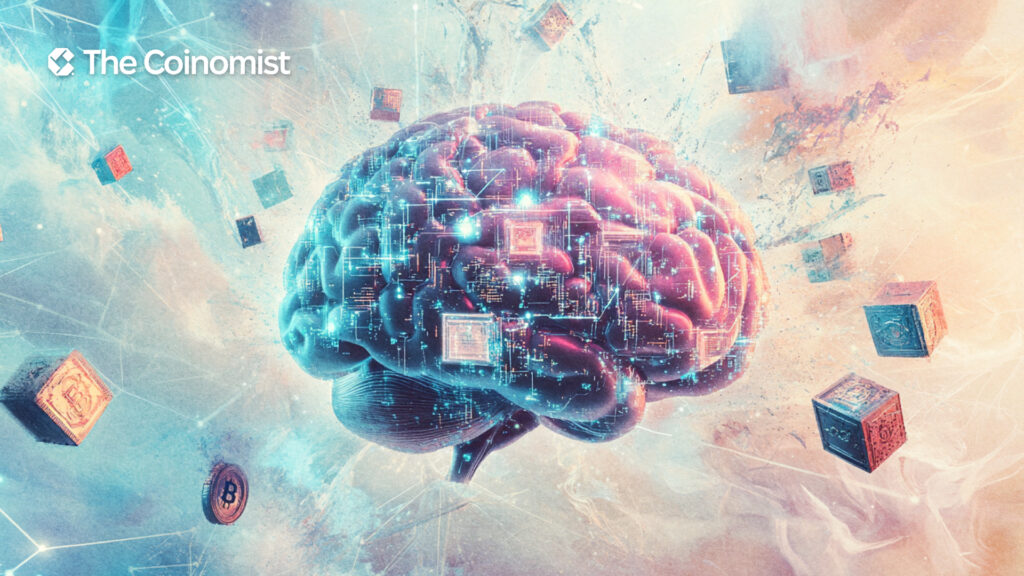
At the end of 2022, a public beta of an AI-powered product quietly launched. It looked like nothing more than a simple chat window. However, it turned out to be a global sensation.
On this page
- A New Wave of AI Born on the Blockchain
- ChatGPT, Crypto and the Rise of AI Tokens
- Sam Altman: Catalyst and Controversy
- From OpenAI to Worldcoin
- The Vision Behind Worldcoin and the Debate It Sparked
- The Man Building in Both Directions
- Flashback: When Sam Altman Questioned Bitcoin
- Rising Demand for Open AI Infrastructure
- What the Research Says: Has the Crypto Market Gotten Smarter Since ChatGPT?
- Study Overview and Purpose
- Key Findings: Market Efficiency and Behavior
- Takeaways for Investors
- The Dawn of the AI Agent Era
- Two Perspectives. One Question
- What’s Next?
Behind the chat was a model trained on an enormous dataset, and a company that would soon dominate global headlines.
The bot’s name was ChatGPT. Its creator was Sam Altman.
Just a few weeks after its launch, ChatGPT became more than just a tech product. It turned into a cultural phenomenon. Students used it to write essays. Developers relied on it to debug code. CEOs quietly spoke of rising productivity. Entire industries began to reconsider their future.
Outside the boardrooms of Silicon Valley and the mainstream conversations about AI, another community was paying close attention—one that had spent years imagining decentralized infrastructure, open data, and autonomous systems. The crypto world saw something different in ChatGPT’s rise.
It saw a spark.
And that spark began to spread.

A New Wave of AI Born on the Blockchain
Crypto has always stood for more than just money. At its core, it has been a response to centralized control—whether from central banks, media conglomerates, or tech giants. So when OpenAI, with backing from Microsoft, released a powerful language model and kept its code closed, the crypto community felt a familiar sense of concern.
“ChatGPT showed us what AI can do. But it also showed us what happens when a few corporations control it,” one Ethereum developer said in a podcast.
By early 2023, the combination of “AI + crypto” had become the next major narrative. Investors, weary of DeFi and NFT trends, seized on it with enthusiasm. But this wasn’t just another hype cycle. The underlying questions were real:
If AI is going to shape the future, who will own it? Who will control it?
For an increasing number of crypto founders, the idea that OpenAI and three corporations might hold that control was not an acceptable answer.
ChatGPT, Crypto and the Rise of AI Tokens
The success of ChatGPT became a turning point, sparking a surge of investor interest in AI tokens.
Projects like Fetch.ai, Ocean Protocol, SingularityNET, and Numeraire began offering a different vision—one where AI models are open, data is decentralized, and computing power is shared across blockchain networks.
- Ocean Protocol is focused on tokenized data marketplaces designed to support AI model training.
- Fetch.ai is developing infrastructure for autonomous agents that can operate and interact within blockchain ecosystems.
- Render Network allows users to access GPU power on demand through a decentralized system.
At their core, these projects set out to make AI resources and infrastructure more accessible. If data is the new oil and computing power is the new currency, crypto is a way to keep both in the public domain.
The market responded.
Throughout 2023 and 2024, many of these tokens gained in value and popularity, driven by a mix of excitement and real progress. VC firms revised their presentations. Founders refined their pitches.
AI had officially made its entrance into crypto.
Related: The Rise of Artificial Intelligence Coins
Sam Altman: Catalyst and Controversy
From OpenAI to Worldcoin
The irony is hard to miss: Sam Altman didn’t just fast-track the global adoption of AI; he also came to represent the very forces crypto set out to resist.
As the CEO of OpenAI, Altman embodied a centralized, corporate model of AI development.Yet, at the same time, he was launching Worldcoin, a crypto project built around biometric identification and the idea of universal basic income.
The Vision Behind Worldcoin and the Debate It Sparked
Worldcoin proposed a concept that was both ambitious and divisive: users would scan their irises using a metallic orb, verify their identity as real humans, and receive tokens in exchange. Sam Altman framed the project as a way to separate humans from AI in a world where generative models can fake everything, from text to identity.
The crypto community responded with mixed opinions.
Some saw it as a practical solution to Sybil attacks, a real threat to decentralized networks.Others criticized it as dystopian. The same person who helped unleash synthetic intelligence now wanted people to scan their eyes to access the economy.
The Man Building in Both Directions
However, one thing was clear: Sam Altman didn’t just talk about the future at the intersection of AI and crypto.
He was shaping it, pushing forward on both fronts at the same time.
Flashback: When Sam Altman Questioned Bitcoin
More than ten years before Worldcoin and its iris-scanning orb, Sam Altman took a very different stance on crypto. In a blog post from the early 2010s, he openly and somewhat skeptically reflected on Bitcoin’s future.
“When friends ask me how to buy bitcoin, I always ask why they want to buy before I help. The main driver is the very human desire to get rich quickly without doing much work… the tulip strategy.”
The contrast couldn’t be sharper. A decade later, Altman distributes a new kind of cryptocurrency through biometric scanning, trying to verify real human identity in a world where AI can fake nearly everything.
He also offered a warning:
“A currency without the major use case being legitimate transactions is going to fail.”
Today, that quote hits differently. Worldcoin hasn’t turned into a currency for everyday use. Instead, it stands as a bold experiment: still speculative, still evolving, and still searching for real-world utility.
However, even with his early skepticism, Altman seemed to grasp the scale of what lay ahead:
“It’d be stupid to convert all your dollars to bitcoin. It’d be stupid not to pay attention.”
A decade later, in 2025, he no longer watches from the sidelines.
He shapes the intersection of AI and crypto and pushes the conversation forward, possibly even setting the rules for what comes next.
While Altman’s personal shift tells part of the story, the broader crypto ecosystem has started to respond in its own way—by building.
Related: Worldcoin Reborn: Enter World Network
Rising Demand for Open AI Infrastructure
As artificial intelligence began reshaping business, journalism, art, and even legal systems, calls for open AI infrastructure grew louder, especially within the Web3 community.
Projects started focusing on several key areas:
- On-chain training incentives for models
- Tokenized datasets owned by communities
- Decentralized compute networks using idle GPU resources
- DAO governance for how models are fine-tuned and deployed
These weren’t just abstract ideals. They directly challenged the closed approach of labs like OpenAI, Anthropic, and others. The crypto community pushed for a future where AI wouldn't belong to a select few but would be governed by many.
The timing made sense. While regulators moved slowly and centralized players tightened their control, Web3 turned into a testing ground for AI, offering fewer restrictions and more space for ambitious ideas.

What the Research Says: Has the Crypto Market Gotten Smarter Since ChatGPT?
Study Overview and Purpose
In 2024, researchers at the Lisbon School of Economics and Management published a study titled “The AI revolution: are crypto markets more efficient after ChatGPT 3?”
They set out to answer a clear and important question: Did the arrival of ChatGPT influence how participants behave in the crypto market, especially in AI-related sectors?
The conclusion?
It had a significant impact.
Related: OpenAI Investigates ChatGPT Bias
Key Findings: Market Efficiency and Behavior
Using advanced efficiency metrics and sector analysis, the researchers found that AI tokens showed clear improvements after the launch of ChatGPT-3.
Specifically, sectors such as generative AI, AI big data, and distributed computing saw noticeable changes:
- Higher average returns
- Improved liquidity
- Faster response to new information
Meanwhile, less developed areas, like cybersecurity, showed less consistency. These sectors only saw gains in efficiency during periods of strong market rallies or steep declines.
Related: 47% of Users Are Bullish on Crypto AI Projects
Takeaways for Investors
The researchers made one thing clear: the AI and crypto connection isn’t just hype. It actively reshapes how markets behave. Liquidity flows, price formation, and volatility shifted after ChatGPT entered the crypto scene, showing that investor interest in AI projects keeps growing.
“Efficiency in crypto markets is no longer static. It evolves with technology—and ChatGPT was a turning point,” the authors wrote.
Their core message?
The crypto AI space creates real opportunities, but it also demands strong insight.
Furthermore, investors who want to ride the next wave need to think strategically, choose their timing carefully, and stay alert to how market dynamics evolve in real time.
Related: Scientists Can Spot ChatGPT in Academic Texts with 99% Accuracy
The Dawn of the AI Agent Era
By 2025, the fusion of AI and blockchain showed up more clearly than ever.
Smart contracts started working alongside autonomous agents. AI agents took over wallet management on-chain. Bots began executing trades based on natural language prompts. AI assistants helped users navigate DeFi, file taxes, and draft governance proposals for DAOs.
What started in early 2023 as a wave of speculative tokens evolved into a new stage of blockchain infrastructure design.
The narrative shifted from “AI in crypto” to “AI as a core layer of crypto infrastructure.”
Projects turned ideas like decentralized AI inference, tokenized APIs, and collaborative model training into functioning protocols.
Related: Bots in Crypto: Their Roles, Impacts, and Detection Methods
Two Perspectives. One Question
The movement at the crossroads of crypto and AI still stands in its early stages. Most projects in this space remain small, experimental, and unproven. However, the ideas keep gaining momentum and more often, they challenge the very model OpenAI represents.
Meanwhile, Sam Altman seems to be tackling the problem from both sides.
On one hand, he runs the world’s most powerful closed AI lab.
On the other hand, he backs blockchain tools meant to protect humanity from the same models he helped create.
This creates a contradiction.
But it also sends a message.
No single side will shape the future alone.
Without Sam Altman's ChatGPT, crypto might never have seen the AI wave.
However, because of Sam Altman, it might never become fully decentralized.

What’s Next?
ChatGPT gave the world a glimpse of what artificial intelligence can become. But it also posed a fundamental question to the blockchain community: How can we make sure this power stays distributed?
That question sparked a movement.
From Worldcoin to open-source model marketplaces, from decentralized GPU networks to autonomous agents governed by DAOs—a new frontier is taking shape. And this time, it's not just about tokens.
We're watching a new kind of architecture emerge, grounded in transparency, autonomy, and shared control.
The content on The Coinomist is for informational purposes only and should not be interpreted as financial advice. While we strive to provide accurate and up-to-date information, we do not guarantee the accuracy, completeness, or reliability of any content. Neither we accept liability for any errors or omissions in the information provided or for any financial losses incurred as a result of relying on this information. Actions based on this content are at your own risk. Always do your own research and consult a professional. See our Terms, Privacy Policy, and Disclaimers for more details.
